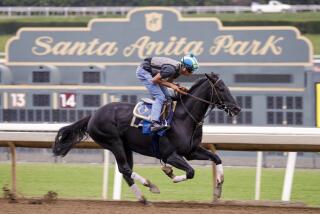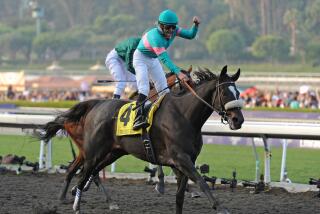HORSE RACING : Pimlico, Laurel Lost Nearly $850,000 in ’90
Saddled with rising expenses and long-term debt, Maryland’s two major thoroughbred tracks, Pimlico and Laurel, lost $849,058 in 1990, the Maryland Racing Commission has been told.
The two harness tracks, Rosecroft in Oxon Hill and Delmarva Downs near Ocean City, are in bankruptcy proceedings and are operating under a court-appointed trustee.
The tracks were seized by the state last fall after the racing commission found that Vogel, owner of both tracks, had borrowed millions from the operations. Vogel subsequently put his enterprises into Chapter 11 bankruptcy.
As for Maryland’s fifth track, Timonium in Baltimore County, it had a loss of $20,072 in 1990 compared with a profit of $225,989 in 1989. The track is run by the Maryland State Fair and Agriculture Society Inc.
But the biggest surprise in the annual audited financial reports required by the racing commission was that Pimlico Race Course in Baltimore lost $483,972 last year and Laurel Race Course in Laurel lost $365,086.
Moreover, 1991 has been disappointing for them so far. At the Laurel winter meet, betting and attendance were off about 5 percent from last year. And business during the first days at Pimlico shows a decline of about 8 percent from 1990.
Both tracks are headed by Joseph A. De Francis, who said that the long-term survival of Pimlico and Laurel may depend on the eventual approval of off-track betting by the General Assembly. The legislature, though, has tabled the issue for this year.
Alan M. Foreman, the lawyer for horse-owner associations covering both thoroughbred and harness racing in Maryland, cautions against a gloom-and-doom view of the future of racing because the picture can change greatly from year to year.
“The health of the industry is very much tied to attendance and the amount wagered,” says Foreman, who represents both the Maryland Thoroughbred Horsemen’s Association and the Cloverleaf Horsemen’s Association, the harness-racing group.
According to the financial reports, the Laurel racetrack had a long-term debt of $15.7 million at the end of 1990 and Pimlico had a long-term debt of $24.2 million. The debts are from the purchase of Laurel in December 1984 and Pimlico in December 1986.
De Francis said the losses at Laurel and Pimlico point to the need for the “major structural change” of an off-track betting system. “We hope to survive over the short run, but not over the long run,” he said about the outlook for racing.
The two tracks have tried to trim costs by working more efficiently, De Francis said, but the operations are restricted in how much they can cut without hurting the entertainment value of the tracks.
“We are not in the kind of business where you can lay off people without impacting the fan experience,” he said. Together, the Laurel and Pimlico operations directly employ about 500 people.
Robert T. Manfuso, a part-owner of Laurel and Pimlico, said, “You have to be concerned about the way things are going.” He was particularly puzzled because business was good at the tracks for the first half of the year. However, he said he has not had a chance to study the financial reports.
A big expense for the tracks is the money paid to winners of the races. Stakes and purses at the two tracks increased by 4 percent from $42.8 million in 1989 to $44.5 million in 1990.
Even though Laurel raced 16 fewer days last year than in 1989, the track showed an increase in attendance. But there was a drop in the amount of money wagered. A total of 1,646,607 fans bet $201,802,265 at Laurel during 1990, compared with 1,490,965 fans who wagered $232,336,871 in 1989.
Pimlico showed increases in both attendance and wagers: A total of 1,235,691 fans bet $234,071,757 in 1990, compared with 1,091,837 fans who bet $193,533,273 in 1989.
The Laurel track alone lost $365,086 in 1990, reducing the owner’s equity at the track from $449,580 at the beginning of 1990 to $84,494 -- only 0.4 percent of the total assets of an $18.6 million operation. Last year’s red ink follows a similar loss in 1989 of $370,312.
One major expense at Laurel during 1990 was payment of $1.9 million in principal and interest on long-term debt.
At Pimlico, the 1990 loss was $483,972, compared to a small profit of $35,949 in 1989. The 1990 loss reduced the track’s capital to $2.5 million, or 8.7 percent of the $29.1 million total assets of the Pimlico track operation.
Unlike Laurel, at Pimlico the amount of money bet in 1990 increased by 20.9 percent compared with the previous year, from $193.5 million to $234.1 million. However, expenses at the track jumped by 20 percent.
De Francis said much of the increase in expenses was due to a new labor contract with the United Food and Commercial Workers that was signed at the end of 1989. That agreement covers about three-fourths of the 500 workers at both Pimlico and Laurel. Expenses were not higher at Laurel because of the fewer racing days, De Francis explained.
More to Read
Get our high school sports newsletter
Prep Rally is devoted to the SoCal high school sports experience, bringing you scores, stories and a behind-the-scenes look at what makes prep sports so popular.
You may occasionally receive promotional content from the Los Angeles Times.






